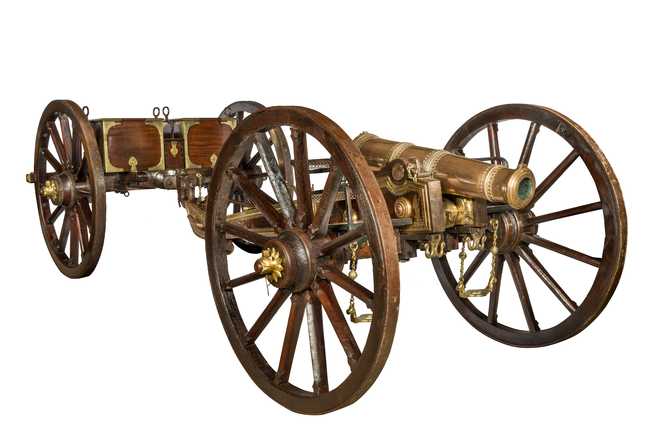
PRIZED WEAPONRY This cannon was captured in the Battle of Gujarat in 1849 when the Sikhs were defeated by the British and surrendered in March 1849 in Rawalpindi. Its wheels are 1.5m in diameter, the brass barrel weighs 315kg and the length of the contraption is 6.5m. This includes the gun and the carriage with the two-wheel cart attached. Photo courtesy: Chris Challis
Shyam Bhatia
THE power and glory of Maharaja Ranjit Singh’s kingdom will be depicted through a unique exhibition that is due to open next month at the Brunei Gallery in London.
Among the highlights of the ‘Empire of the Sikhs’ exhibition opening on July 12 is a major cannon captured during the Second Anglo-Sikh War in 1849 when East India Company mercenaries wrested control of Punjab, ransacking the royal treasury and forcing the abdication of the boy-king Duleep Singh, who was later baptised as a Christian and sent to live in the UK. He reverted to Sikhism before he died.
The looting of the Lahore treasury, which was then the richest in the world with the Kohinoor diamond among its prize possessions, and denying Duleep Singh access to his legitimate heritage, ranked among the more shaming episodes of colonial history.
The cannon being exhibited (see picture and attribution) is one of a pairs gifted to the commander-in-chief of the British forces, General Sir Hugh Gough.
Among the other objects on display will be items from the private Toor Collection, as well as objects from the British Library, the Victoria and Albert Museum and the National Art Museum in London.
They include an array of Sikh swords, the golden shield of Maharaja Ranjit Singh’s feared general Hari Singh Nalwa, as well as samples of jewellery worn by Maharani Jindan Kaur.
Among other items is the gold enamelled setting in which the Kohinoor was set. A cast was made of the original Kohinoor and put in its original bazubandh.
Explaining the significance of the cannon and other artillery pieces, exhibition curator Parmjit Singh says, “The cannon was cast in the last few years of Maharaja Ranjit Singh, probably in Lahore, to accompany him on his tours. Ranjit Singh had a fascination for artillery and cannons and had started collecting them early on, with Dutch, Turkish and Indian cannons part of his collection. When he overran a territory, he would collect the artillery.
“He then realised there’s a limited number of cannons you can get from loot. So he established his own foundries where he employed Europeans, in particular one French chap named Claude August Court, who established the casting of guns patterned on English barrels, so much so that you couldn’t tell the difference. “The guns were worshipped by the men who manned them, mainly Muslims and Sikhs. They revered them and treated the guns as instruments of the divine.”
Key portraits of Ranjit Singh’s son and successor, Maharaja Sher Singh, will be on display along with portraits of some firangi generals from France and Italy who served as generals and governors under Ranjit Singh. Not only did Maharaja Ranjit Singh manage to unite and govern the Sikhs, he was insatiably curious and welcomed strategic advice and military innovations from European,” tells Eleanor Nesbitt, Professor Emeritus at Warwick Religions and Education Research Unit.
She says that the Sikh Raj commanded respect, thanks to Maharaja Ranjit Singh’s might in the battlefield and his skills in negotiation.
“It modelled positive relations between Sikhs, Hindus and Muslims. Punjab’s supremely skilled artistes and craftsmen flourished under him and their works remain an impressive legacy of a golden age. British esteem for Sikh valour in successive conflicts after Ranjit Singh’s demise had its roots in the respect for his Sikh empire and he is also remembered for ruling without resorting to capital punishment,” Prof Nesbitt says.



























